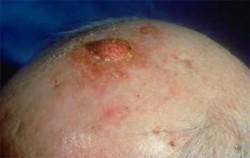By: Carlos Acevedo
 As we finally begin to enjoy some of the hottest days of the summer, some people are beginning to play volleyball at the beach, ride their bikes, jog, while others play softball or sunbathe poolside at the many parks throughout the city.
As we finally begin to enjoy some of the hottest days of the summer, some people are beginning to play volleyball at the beach, ride their bikes, jog, while others play softball or sunbathe poolside at the many parks throughout the city.
Normally it’s all fun and games but its time to look at some of the often-overlooked risks associated with the summer.
It’s probable that while enjoying the weather and the many outdoor activities available in the summer, most people are not thinking about skin cancer.
Regardless if your exposure to the sun is due to your occupation or pleasure, the one thing that everybody has in common is that everybody is at risk of skin cancer.
Dr. Meyer A. Horn, a dermatologist and partner at Dermatology & Aesthetics of Wicker Park said that some people believe that because their skin tone may already be tan, that they’re no longer at risk of getting skin cancer.
“That is false, regardless of peoples skin tone, whether they’re very fair or very dark, or even somewhere in between, everyone needs to realize that no matter what color their skin is, they can all get skin cancer,” said Dr. Horn.
 The following are two categories of skin cancer that are often checked by dermatologists and are also the most common in the United States.
The following are two categories of skin cancer that are often checked by dermatologists and are also the most common in the United States.
Basal Cell Carcinoma (BCC):
- Grows slowly and rarely spreads to other parts of the body
- Usually develops on the face, often forming on the nose
- Can develop on any part of the body, including legs, arms and trunk
- Treatment is important because BCC can grow wide and deep, destroying skin tissue and bone
According to the American Academy of Dermatology, basal cell carcinoma is the most common form of skin cancer and more than two million cases are diagnosed in the United States, each year.
Squamous Cell Carcinoma (SCC):
- Grows more rapidly than basal cell carcinoma
- Can develop on any part of the body including head, neck, back of hands and inside the mouth, lips and genitals
- Can spread, especially if located on the ear, forehead, lip or top of the hand
- Women frequently get SCC on lower legs
- Highly curable with early diagnosis and treatment
“Most of the time, these two types of skin cancer (BCC and SCC) are caught pretty early and they don’t really hurt anybody, beside leaving a few bad scars,” said Dr. Horn.
Basal (BCC) and squamous (SCC) cancers have no relationship to moles and don’t even look like moles. They are typically scaly and crusty spots that develop in sun exposed areas. Usually, they bleed recurrently when picked at and don’t heal but continue to grow. They are associated with heavy sun exposure and history of sunburns.
Melanoma and Moles
A third category of skin cancer is called Melanoma (also known as Malignant Melanoma), which is not the most common but the most serious and has a relationship to moles. “If melanoma is not caught early, it can kill people because it can metastasize and then spread to other parts of the body. Chemotherapy or other treatments are necessary and sometimes, unfortunately, the treatments are not very effective against it. So when people have advanced melanoma, they usually don’t survive,” said Dr. Horn.
Signs of Melanoma
According to Dr. Horn, if you have many moles and you notice that a specific mole that you’ve had for many years is changing in color, size or shape or if after several weeks, you develop a new mole that looks different from the other moles because it’s darker or of a different size, those can be signs that the mole can already be a melanoma or could be changing into a melanoma.
If you have many moles, it doesn’t mean that you will automatically develop skin cancer but it is recommended that you keep an eye on them and get checked.
“Many people of Latin background have a lot of moles and most of the time, they are totally fine and they’ll never be a problem. The problem is that if most people are not paying attention to their moles or having their husband or wife keep an eye on them, then something can change without them knowing and they can get a melanoma cancer,” said Dr. Horn.
Treatment of Skin Cancer
According to Dr. Horn, 99 percent of the time, the dermatologist will surgically cut out the cancer-affected area and stitch it back up.
“The only time when that is not the case is when it’s a melanoma cancer that is very high risk and that has spread to other areas of the body. In that case they may need more chemotherapy or radiation type of treatments, but luckily that is not very common,” said Dr. Horn.
Stay Away from Tanning Beds!
According to Dr. Horn, tanning beds are dangerous because they are not regulated very well.
“Some of the tanning beds emit harmful radiation that can increase a persons risk for skin cancer. If people want to look darker, instead they can use the spray tanning, airbrush tanning or the fake tanner in the bottle because those are a much safer alternative,” said Dr. Horn.
Besides the harmful radiation, tanning beds age the skin, increases the risk for skin cancer and are considered more dangerous than direct sun exposure.
“There’s not a standard that they have to be up to, for example, one tanning bed salon may have new machines that are safer and another salon may have older machines with old light bulbs that haven’t been calibrated which may be emitting more amounts of dangerous radiation,” said Dr. Horn.
Ways to Protect Against the Sun
- Generously apply sunscreen 30 minutes before sun exposure
- Use sunscreen with SPF 30 during the summer months and at least SPF 15 daily, year round
- Wear protective clothing: long sleeve shirts, pants and wide brimmed hats and sunglasses
- Keep infants (less than 6 months old) out of direct sunlight
Remember, even people with darker skin types who can tan very easily in the sun, should still be proactive about using sunscreen. Especially if outdoor work is involved, not only to reduce the risk of skin cancer but also to reduce the “wear and tear” of the skin.
Recommendations
It is recommended that people who are 40 years and older get a skin cancer check at least one time. Based on what the dermatologist sees in the exam, he or she will then advise on how frequently to check after that.
For people who have five to ten really dark moles or a big birth mark mole that they’ve had since childhood, then it should be checked sooner, even when they are teenagers.
If there is a concern about a mole, people can initially ask their primary care doctor to take a look. The primary care doctor should be able to determine if seeing a dermatologist is necessary.
“If the primary care doctor is uncomfortable giving them advice about their particular moles, or doesn’t have much expertise, then that person should absolutely see a dermatologist,” said Dr. Horn.
If you have any questions regarding skin cancer or would like to set up a skin cancer exam, you can contact Dr. Horn at Dermatology & Aesthetics of Wicker Park at 773-276-1100 or visit their website at: www.wickerparkderm.com.
Dr. Horn Bio
Meyer A. Horn, MD is a Clinical Instructor of Dermatology at the Feinberg School of Medicine of Northwestern University, and he is a Diplomate of the American Board of Dermatology.








